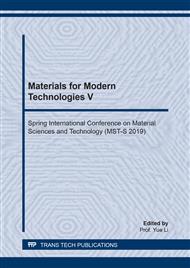[1]
P. Maruschak, L. Poberezhny, T. Pyrig, Fatigue and brittle fracture of carbon steel of gas and oil pipelines, Transport. 28 (2013) 270-275.
DOI: 10.3846/16484142.2013.829782
Google Scholar
[2]
L. Poberezhnyi, P. Maruschak, O. Prentkovskis, I. Danyliuk, T. Pyrig and J. Brezinová, Fatigue and failure of steel of offshore gas pipeline after the laying operation, Arch. Civ. Mech. Eng. 16 (2016) 524-536.
DOI: 10.1016/j.acme.2016.03.003
Google Scholar
[3]
L. Poberezhny, P. Maruschak, A. Hrytsanchuk, L. Poberezhna, O. Prentkovskis, and A. Stanetsky, Impact of gas hydrates and long-term operation on fatigue characteristics of pipeline steels, Procedia Eng. 187 (2017) 356-362.
DOI: 10.1016/j.proeng.2017.04.386
Google Scholar
[4]
M.A. Nevesbeltrão, E.M. Castrodeza, F.L. Bastian, Fatigue crack propagation in API 5L X-70 pipeline steel longitudinal welded joints under constant and variable amplitudes, Fatigue Fract. Eng. Mater. Struct. 34 (2010) 321-328.
DOI: 10.1111/j.1460-2695.2010.01521.x
Google Scholar
[5]
V.D. Makarenko, V.A. Belyaev, N.N. Prokhorov, S.P. Shatilo and V.Y. Chernov, Effect of modifying microadditions on the mechanical and ductility properties of welded joints in oil and gas pipelines, Weld. Int. 15(2001)808-811.
DOI: 10.1080/09507110109549446
Google Scholar
[6]
A.K. Sisi, S.E. Mirsalehi, Prediction of microstructure and mechanical properties of line pipe welded joints based on hardness map, Sci. Technol. Weld. Joining. 21 (2015) 43-52.
DOI: 10.1179/1362171815y.0000000064
Google Scholar
[7]
C. Ennaceur, A. Laksimi, C. Herve and M.Cherfaoui, Monitoring crack growth in pressure vessel steels by the acoustic emission technique and the method of potential difference. Int. J. Pressure Vessels Piping. 83 (2006) 197-204.
DOI: 10.1016/j.ijpvp.2005.12.004
Google Scholar
[8]
R.M. Meyer, S.E. Cumblidge, P. Ramuhalli and B.E. Watson, Acoustic emission and guided wave monitoring of fatigue crack growth on a full pipe specimen, Proc. SPIE, Health Monitoring of Structural and Biological Systems, 7984 (2011) 798424.
DOI: 10.1117/12.881795
Google Scholar
[9]
Z.Y. Wang, Acoustic emission technology foundation, first ed., Shandong science and technology press, Shan Dong, (1990).
Google Scholar
[10]
J.H. Yang, F. Chen, S. Cheng, Y.J. Wang, Q.J. Lü and M.H. Yu, Experimental research on the fatigue crack growth rate of raw material, weld seam and heat-affected zone of high pressure vessel, Mech. Sci. Tech. 22 (2003) 126-128.
Google Scholar
[11]
Y.W. Shi B.Y. Chen J.X. Zhang, Effects of welding residual stresses on fatigue crack growth behavior in butt welds of a pipeline steel, Eng. Fract. Mech. 36 (1990) 893-902.
DOI: 10.1016/0013-7944(90)90266-j
Google Scholar
[12]
S.T. Dai, J.F. Labuz, Damage and failure analysis of brittle materials by acoustic emission, J. Mater. Civ. Eng. 9 (1997) 200-205.
DOI: 10.1061/(asce)0899-1561(1997)9:4(200)
Google Scholar


